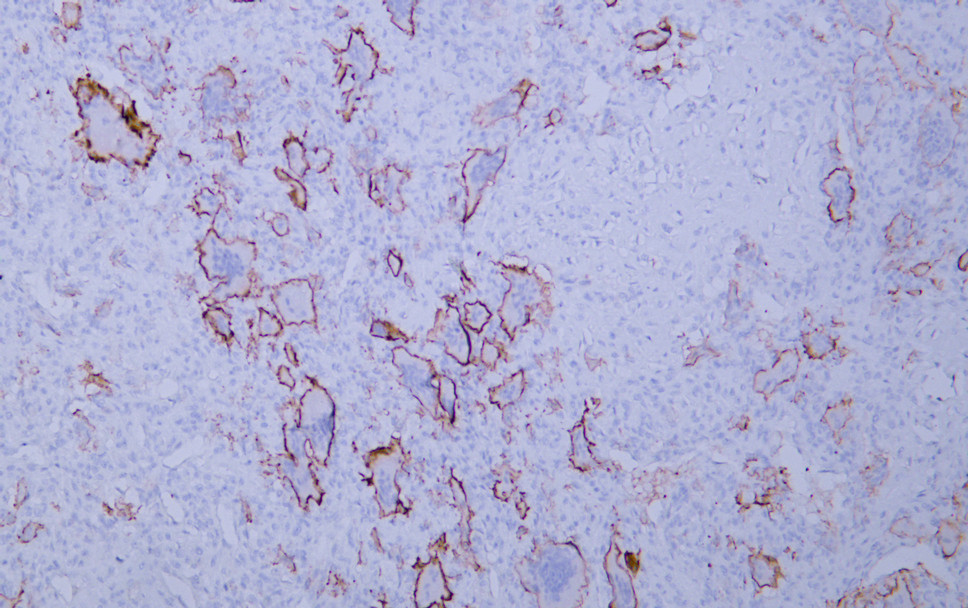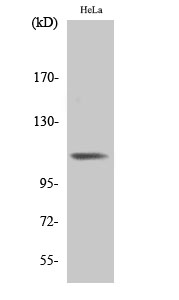Total Integrin β3 Cell-Based Colorimetric ELISA Kit
- Catalog No.:KA4140C
- Applications:ELISA
- Reactivity:Human;Mouse
- Gene Name:
- ITGB3
- Human Gene Id:
- 3690
- Human Swiss Prot No:
- P05106
- Mouse Swiss Prot No:
- O54890
- Storage Stability:
- 2-8°C/6 months
- Other Name:
- Integrin beta-3 (Platelet membrane glycoprotein IIIa) (GPIIIa) (CD antigen CD61)
- Detection Method:
- Colorimetric
- Background:
- disease:Defects in ITGB3 are a cause of Glanzmann thrombasthenia (GT) [MIM:273800]; also known as thrombasthenia of Glanzmann and Naegeli. GT is the most common inherited disease of platelets. Its inheritance is autosomal recessive. It is characterized by mucocutaneous bleeding of mild-to-moderate severity and the inability of this integrin to recognize macromolecular or synthetic peptide ligands. GT has been classified clinically into types I and II. In type I, platelets show absence of the glycoprotein IIb-IIIa complexes at their surface and lack fibrinogen and clot retraction capability. In type II, the platelets express the GPIIb-IIIa complex at reduced levels (5-20% controls), have detectable amounts of fibrinogen, and have low or moderate clot retraction capability. The platelets of GT variants have normal or near normal (60-100%) expression of dysfunctional receptors.,function:Integrin alpha-V/beta-3 is a receptor for cytotactin, fibronectin, laminin, matrix metalloproteinase-2, osteopontin, osteomodulin, prothrombin, thrombospondin, vitronectin and von Willebrand factor. Integrin alpha-IIb/beta-3 is a receptor for fibronectin, fibrinogen, plasminogen, prothrombin, thrombospondin and vitronectin. Integrins alpha-IIb/beta-3 and alpha-V/beta-3 recognize the sequence R-G-D in a wide array of ligands. Integrin alpha-IIb/beta-3 recognizes the sequence H-H-L-G-G-G-A-K-Q-A-G-D-V in fibrinogen gamma chain. Following activation integrin alpha-IIb/beta-3 brings about platelet/platelet interaction through binding of soluble fibrinogen. This step leads to rapid platelet aggregation which physically plugs ruptured endothelial surface. In case of HIV-1 infection, the interaction with extracellular viral Tat protein seems to enhance angiogenesis in Kaposi's sarcoma lesions.,online information:The Singapore human mutation and polymorphism database,polymorphism:Position 169 is associated with platelet-specific alloantigen HPA-4 (PEN or YUK). HPA-4A/PEN(A)/YUK(A) has Arg-169 and HPA-4B/PEN(B)/YUK(B) has Gln-169. HPA-4B is involved in neonatal alloimmune thrombocytopenia (NAIT or NATP).,polymorphism:Position 433 is associated with platelet-specific alloantigen MO. MO(-) has Pro-433 and MO(+) has Ala-433. MO(+) is involved in NAIT.,polymorphism:Position 515 is associated with platelet-specific alloantigen CA/TU. CA(-)/TU(-) has Arg-515 and CA(+)/TU(+) has Gln-515. CA(+) is involved in NAIT.,polymorphism:Position 59 is associated with platelet-specific alloantigen HPA-1 (ZW or PL(A)). HPA-1A/ZW(A)/PL(A1) has Leu-59 and HPA-1B/ZW(B)/PL(A2) has Pro-59.,polymorphism:Position 662 is associated with platelet-specific alloantigen SR(A). SR(A)(-) has Arg-662 and SR(A)(+) has Cys-662.,PTM:Phosphorylated on tyrosine residues in response to thrombin-induced platelet aggregation. Probably involved in outside-in signaling. A peptide (AA 740-762) is capable of binding GRB2 only when both Tyr-773 and Tyr-785 are phosphorylated. Phosphorylation of Thr-779 inhibits SHC binding.,similarity:Belongs to the integrin beta chain family.,similarity:Contains 1 VWFA domain.,subunit:Heterodimer of an alpha and a beta subunit. Beta-3 associates with either alpha-IIb or alpha-V. Isoform Beta-3C interacts with FLNB. Interacts with HIV-1 Tat.,tissue specificity:Isoform beta-3A and isoform beta-3C are widely expressed. Isoform beta-3A is specifically expressed in osteoblast cells; isoform beta-3C is specifically expressed in prostate and testis.,
- Function:
- cell-substrate junction assembly, cell adhesion, cell-matrix adhesion, cell surface receptor linked signal transduction,integrin-mediated signaling pathway, blood coagulation, hemostasis, response to wounding, negative regulation of biosynthetic process, negative regulation of macromolecule biosynthetic process, negative regulation of macromolecule metabolic process, regulation of foam cell differentiation, negative regulation of foam cell differentiation, regulation of receptor biosynthetic process, negative regulation of receptor biosynthetic process,regulation of lipid storage, negative regulation of lipid storage, biological adhesion, regulation of cell migration, cell-substrate adhesion, regulation of cellular protein metabolic process, negative regulation of cellular protein metabolic process, regulation of lipid transport, negative regulation of lipid transport, cell junction asse
- Subcellular Location:
- Cell membrane ; Single-pass type I membrane protein . Cell projection, lamellipodium membrane . Cell junction, focal adhesion . Cell junction, synapse, postsynaptic cell membrane ; Single-pass type I membrane protein . Cell junction, synapse .
- Expression:
- Isoform beta-3A and isoform beta-3C are widely expressed. Isoform beta-3A is specifically expressed in osteoblast cells; isoform beta-3C is specifically expressed in prostate and testis.
- June 19-2018
- WESTERN IMMUNOBLOTTING PROTOCOL
- June 19-2018
- IMMUNOHISTOCHEMISTRY-PARAFFIN PROTOCOL
- June 19-2018
- IMMUNOFLUORESCENCE PROTOCOL
- September 08-2020
- FLOW-CYTOMEYRT-PROTOCOL
- May 20-2022
- Cell-Based ELISA│解您多样本WB检测之困扰
- July 13-2018
- CELL-BASED-ELISA-PROTOCOL-FOR-ACETYL-PROTEIN
- July 13-2018
- CELL-BASED-ELISA-PROTOCOL-FOR-PHOSPHO-PROTEIN
- July 13-2018
- Antibody-FAQs


